I do not know what it is about my parents coming to visit but
in the two years since I have been living in Lowestoft, I do not think the
weather has ever been kind to us and once again it was grey, breezy and then
wet!
They came up on the weekend of the 19th and 20th and we poodled out as ever and visited the Stalham street fair
(noting some random moth leaf mines as I wandered around) before lunch at
Poppylands with the rain pattering on the roof!
We stopped at Links Road on the way back so that Dad could see the sea. Several Med Gulls were on the beach and Kittiwakes were
heading back into town where we saw many well grown chicks on the ledges.
Of course it was fine on Tuesday and Wednesday when I
managed to get out and potter around the garden with the local Swifts still
screaming overhead and the Buzzards getting grief from the Herring Gulls. The Tansy Fennel and Ragwort were literally buzzing with Hoverflies and Bees and a lone Migrant Hawker was patrolling.
 |
| Heriades truncorum |
 |
| I think it is Colletes daviesanus on the Tansy |
And so to Thursday where a Roseate Tern off Links Road
interrupted breakfast. I had not seen
one for some time and so headed that way and into the squally rain that waited
for me to step outside. It was grim and
I tried to position my car accordingly before remembering than by drivers
window is currently not working. Anyway,
I soon picked up from a jaunty angle on one of the groynes and then gave the
rain a few minutes to abate before pottering down for a closer look. It glowed white and was flanked by two
Sandwich Terns while hefty, grey looking Common Terns were on other posts and
included some juveniles. It never flew
while we were watching and in fact snuck off completely while we glanced the
other way! A big Grey Seal was munching a large flat fish offshore.
 |
| Roseate Tern |
 |
| Roseate Tern with ad & juv Common Terns - Andrew Easton |
I popped out on Friday morning in the lovely sunshine and
took myself for a walk around Carlton Marshes but this time I took the public footpath
towards Oulton Broad before looping back to the main drag via the track where
we watched the Red-foots in the spring and then back to the centre.
Needless to say it was an insect heavy walk and I was
pleased with 14 Butterfly species which included two Painted Ladies, four Wall
Browns and a Purple Hairstreak which came down to the Hemp Agrimony for lunch.
|
Large White
|
26
|
|
Small White
|
12
|
|
Green veined
White
|
2
|
|
Red Admiral
|
4
|
|
Small
Tortoiseshell
|
1
|
|
Comma
|
1
|
|
Peacock
|
39
|
|
Painted Lady
|
2
|
|
Wall Brown
|
4
|
|
Meadow Brown
|
53
|
|
Gatekeeper
|
132
|
|
Large Skipper
|
2
|
|
Small Skipper
|
1
|
|
Common Blue
|
2
|
|
Brown Argus
|
1
|
|
Purple
Hairstreak
|
1
|
|
|
|
.JPG) |
| Meadow Brown |
.JPG) |
| Meadow Brown |
.JPG) |
| Peacock |
.JPG) |
| Gatekeeper |
.JPG) |
| Wall Brown |
.JPG) |
| Wall Brown |
.JPG) |
| Painted Lady |
.JPG) |
| Painted Lady |
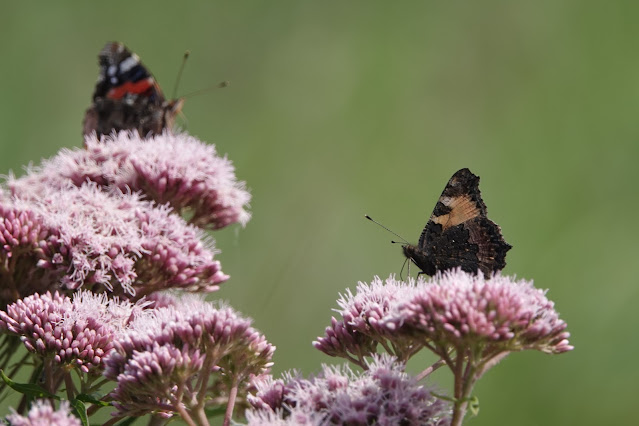.JPG) |
| Small Tortoiseshell |
.JPG) |
| Red Admiral |
.JPG) |
| Peacock |
.JPG) |
Red Admiral
|
.JPG) |
| Purple Hairstreak |
.JPG) |
| Purple Hairstreak |
A big patch of Mint was covered in Greenbottles (get up
close and it smell like a dog poo bin!) and of course Pyrausta aurata and the
Ragwort had the odd Cinnabar moth cat and several Eriothrix rufomaculata – one
of the few Tachinids I think I can identify!
.JPG) |
| Pyrausta aurata |
.JPG) |
| Eriothrix rufomaculata |
Dragons were all around with Brown (21) and Migrant Hawkers (12) in
predominance and I saw neither of the other Emperor species on this particular
loop. There were three Blue Emperors too
and at least six Green-eyed Hawkers on one particular ditch. Brown Hawkers were the commonest with 21
counted!
.JPG) |
| Ruddy Darter |
.JPG) |
| Still airborne! Four Spotted Chaser |
.JPG) |
| Variable Damselfly |
.JPG) |
| Brown Hawker |
.JPG) |
| Blue-tailed Damselflies |
There were plenty of common Hoverflies and the usual
Bumblebees but the stars of the whole walk were a couple of Arachnids.
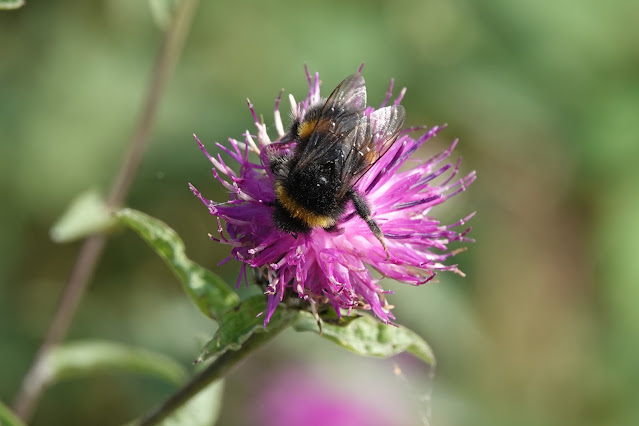.JPG) |
| Bombus terrestris on Knapweed |
.JPG) |
| Syrphus ribesii on Marsh Sow-Thistle |
.JPG) |
| Bombus pascuorum on Great Willowherb |
.JPG) |
| There were 100s of Seven Spot Ladybirds |
.JPG) |
| Robin's Pin Cushion |
.JPG) |
| Gall of Urophora cardui on Creeping Thistle |
.JPG) |
| Yponomeuta sp on Thistle - but not Thistle Ermine |
.JPG) |
| Episyrphus balteatus on Tansy |
.JPG) |
| Colletes daviesanus on Tansy |
.JPG) |
| Colletes daviesanus on Tansy |
I had never seen Fen Raft Spider despite checking the
ditches at Carlton every visit and yet the first scan of a ditch and there was
an immature one (about 10p size) poised and ready sitting on the Frogbit! I carried on and raised my bins again,
scanned along the edge and was suddenly in the presence of a very gravid female
spread out on the surface and ready to pounce.
Each Frogbit leaf is about 50p size so that should give you some idea of
how big she was and although not especially close she was a joy to watch. I kept an eye on her for ten minutes but she
did not flinch so I left her to her hunting and moved on.
.JPG) |
| Fen Raft Spider |
.JPG) |
| Enoplognatha sp with Bombus lapirdarius |
Botanically it was a great walk too.
 |
| from Antony's garden - Small Phoenix |
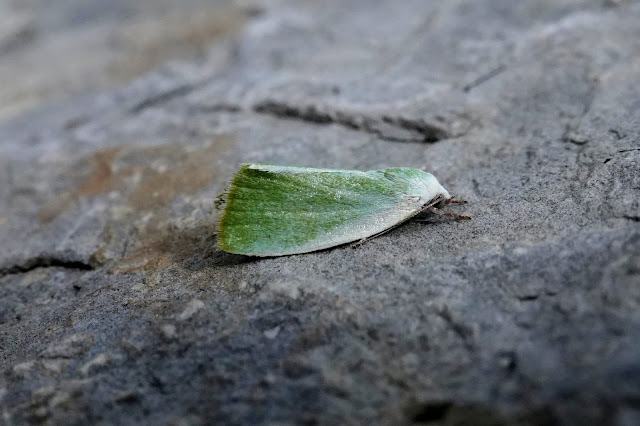 |
| and Cream Bordered Green Pea |
Monday night was better in the garden with 45 species logged including two NFG with the seemingly common Acleris forsskaleana and an Ear Moth although apparently I am not allowed to be able to identify that one… There were more butterflies in the garden too with Red Admirals, Peacock and Large Whites on the Buddleia but none of the Volucella Hoverflies that I had hoped would start to appear.
.JPG) |
| Acleris forsskaleana |
.JPG) |
| Argyritaenia ljunugiana |
.JPG) |
| Dot Moth |
.JPG) |
| Dot Moth |
.JPG) |
| Ear Moth |
 |
| Ear Moth |
.JPG) |
| Iron Prominent |
.jpg) |
| Platytes alpinella |
.JPG) |
Southern Wainscot
|
.jpg) |
| Yellow Barred Brindle |
I trapped again on Tuesday night and was pleased to find some variety in the garden trap. There were some migrants and a lovely Black Arches.
.JPG) |
| Cornonet |
.JPG) |
| Sharp Angled Peacock |
.JPG) |
| Black Arches |
.JPG) |
| Black Arches |
.JPG) |
| Dark Sword Grass |
.JPG) |
| Choreutis nemorana |
.JPG) |
| Cloaked Minor |
.JPG) |
| An even better Platytes alpinella |
.JPG) |
| Ruby Tiger |
.JPG) |
Common Wainscot
|
.JPG) |
Common Plume
|
.JPG) |
| Argyritaenia ljunugiana |
 |
Rush Veneer
|
 |
Rose Tabby - Endothricha flammealis
|
After processing Tuesday nights moths I headed over to Somerleyton to conduct the Butterfly transect while there was still some early warmth in the day and although it was quieter it was still full of insect life. There was a similar suite of species but only three Peacocks and singles of Red Admiral and Painted Lady. A Brimstone was the only new species for me here.
.JPG) |
| Small Copper |
.JPG) |
| Brown Argus |
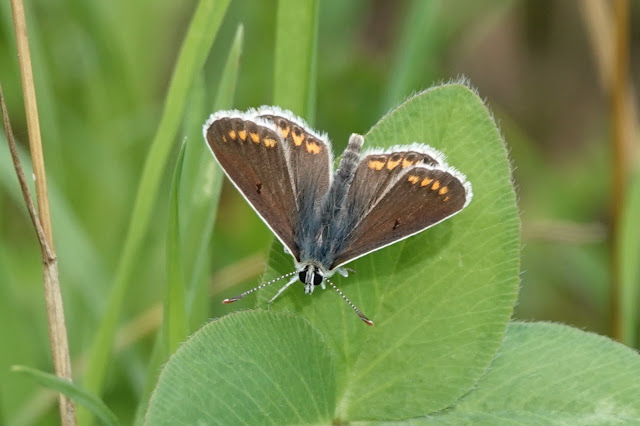.JPG) |
| Brown Argus |
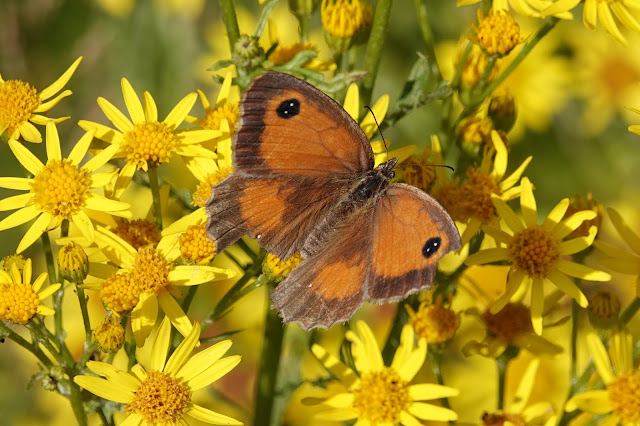.JPG) |
Gatekeeper
|
.JPG) |
| Wall Brown |
.JPG) |
| Rowan |
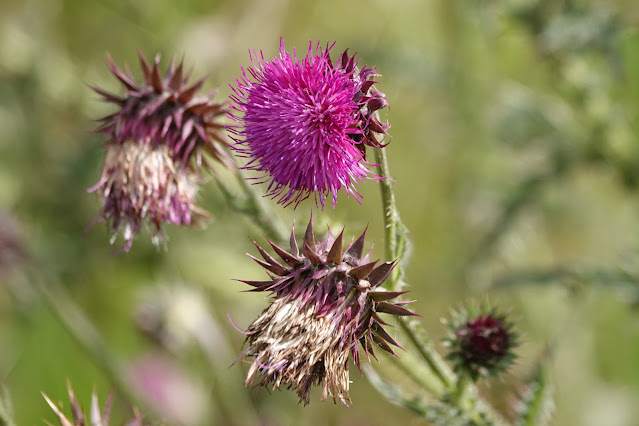.JPG) |
| Nodding Thistle |
.JPG) |
Field Pansy
|
There were a few Grass moths around and I flushed a single Silver Y and a pretty little moth that alighted long enough for some shots. It felt like an Anania but I did not know which at the time.
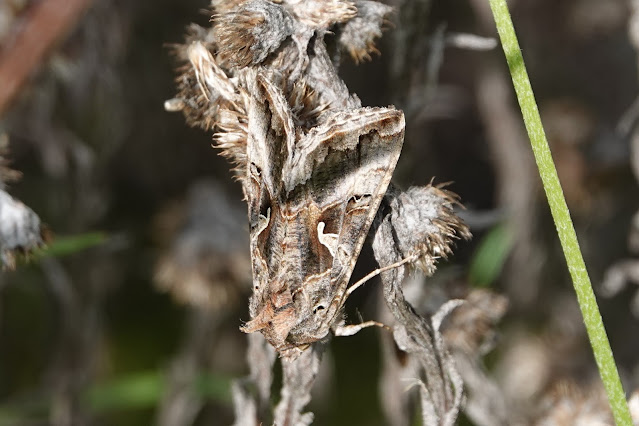.JPG) |
| Silver Y |
.JPG) |
| Wood Sage Pearl - Anania verbascalis |
.JPG) |
| Wood Sage Pearl - Anania verbascalis |
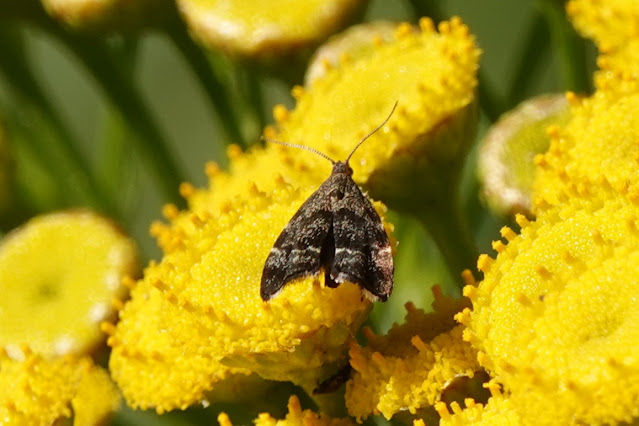.JPG) |
| Nettle Tap |
The woods were quiet with a few calling Chiffchaffs and Treecreepers but the local Buzzards and a fledged brood of Sparrowhawks were certainly not quiet. A family of Whitethroats were foraging in the Brambles as I walked back after another successful amble and as with most recent days the cloud had started to bubble up.
.JPG) |
| Whitethroat |
.JPG) |
| Sparrowhawk |
A final trap on the night of Wednesday gave me 46 species including a fine Tree Lichen Beauty, Flame Shoulder, two Straw Dot, Square Spot Rustic, my first Misutima nitidalis of the year (still in the garage somewhere, sorry) and these four lovelies.
 |
| Surely this has to be a Lesser Common Rustic without the need for the chop? |
 |
| Pebble Hook Tip |
 |
| Coronet |
 |
| Pale Prominent |
Antony also had two new moths to show me from Sh*thouse Chicane...
 |
| Bordered Beauty |
 |
| Evergestis pallidata |




.JPG)
.JPG)
.JPG)
.JPG)
.JPG)
.JPG)
.JPG)
.JPG)
.JPG)
.JPG)
.JPG)
.JPG)
.JPG)
.JPG)
.JPG)
.JPG)
.JPG)
.JPG)
.JPG)
.JPG)
.JPG)
.JPG)
.JPG)
.JPG)
.JPG)
.JPG)
.JPG)
.JPG)
.JPG)
.JPG)
.JPG)
.JPG)
.JPG)
.JPG)
.JPG)
.JPG)
.JPG)
.JPG)
.JPG)
.JPG)
.JPG)
.JPG)
.JPG)
.JPG)
.JPG)
.JPG)
.JPG)
.JPG)
.JPG)
.JPG)
.JPG)
.JPG)
.JPG)
.JPG)
.JPG)
.JPG)
.JPG)
.JPG)
.JPG)
.JPG)
.JPG)
.JPG)
.JPG)


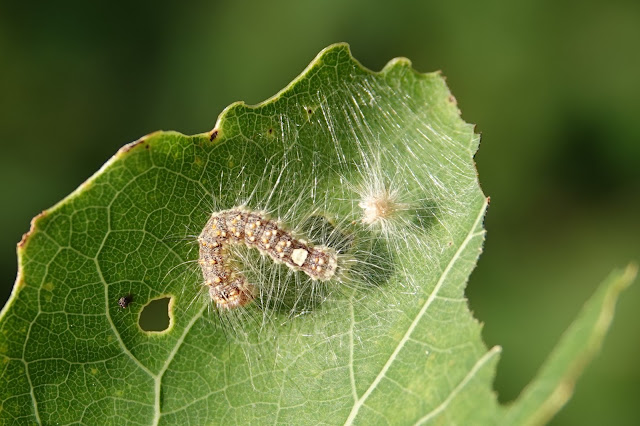
.JPG)
.JPG)
.JPG)
.JPG)
.JPG)
.JPG)
.JPG)
.JPG)
.JPG)
.JPG)
.JPG)
.JPG)
.JPG)
.JPG)
.JPG)
.JPG)
.JPG)
.JPG)
.JPG)
.JPG)
.JPG)
.JPG)
.JPG)
.JPG)
.JPG)
.JPG)
.JPG)
.JPG)
.JPG)
.JPG)
.JPG)
.JPG)
.JPG)
.JPG)
.JPG)
.JPG)
.JPG)
.JPG)
.JPG)
.JPG)
.JPG)
.JPG)
.JPG)
.JPG)
.JPG)
.JPG)
.JPG)
.JPG)
.JPG)
.JPG)
.JPG)
.JPG)
.JPG)
.JPG)
.JPG)
.JPG)
.JPG)
.JPG)
.JPG)
.JPG)
.JPG)
.JPG)
.JPG)
.JPG)
.JPG)
.JPG)
.JPG)
.JPG)
.jpg)
.jpg)
.jpg)
.jpg)
.jpg)
.jpg)
.jpg)
.jpg)
.jpg)


.JPG)
.JPG)
.JPG)
.JPG)
.JPG)

.JPG)
.jpg)
.JPG)
.jpg)
.JPG)
.JPG)
.JPG)
.JPG)
.JPG)
.JPG)
.JPG)
.JPG)
.JPG)
.JPG)
.JPG)
.JPG)


.JPG)
.JPG)
.JPG)
.JPG)
.JPG)
.JPG)
.JPG)
.JPG)
.JPG)
.JPG)
.JPG)
.JPG)
.JPG)
.JPG)
.JPG)
.JPG)
.JPG)
.JPG)
.JPG)
.JPG)
.JPG)
.JPG)
.JPG)





.jpg)
.jpg)
.JPG)
.jpg)
.JPG)
.JPG)
.JPG)
.JPG)
.JPG)
.JPG)
.JPG)
.JPG)
.JPG)
.JPG)
.JPG)
.JPG)
.JPG)
.JPG)


I think that one of your Wall Brown photos might be a small copper.
ReplyDeleteCheers. Cut and paste error
ReplyDelete